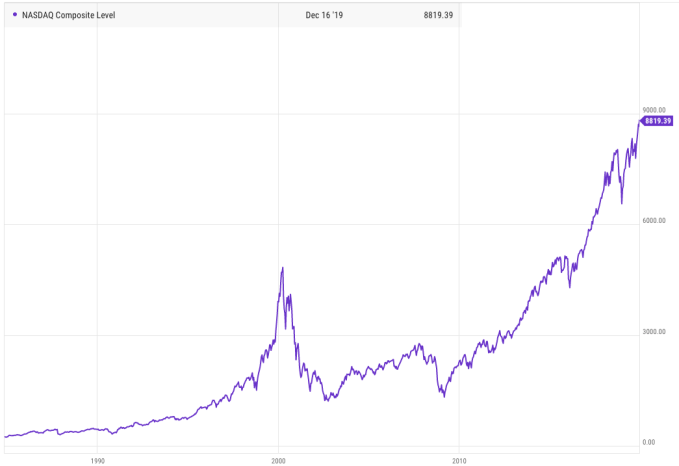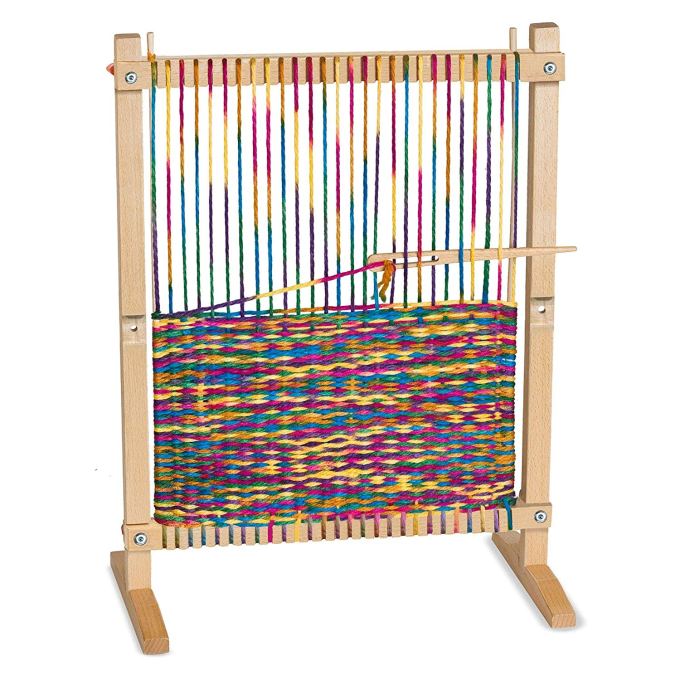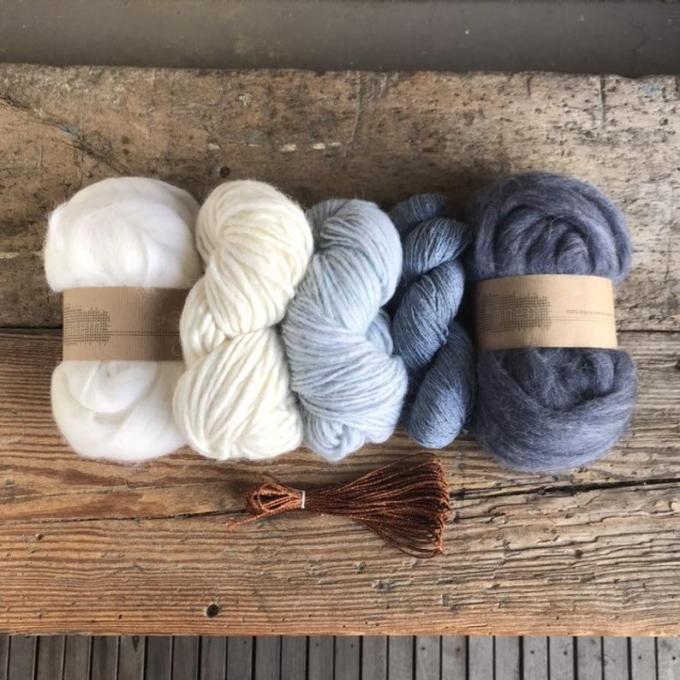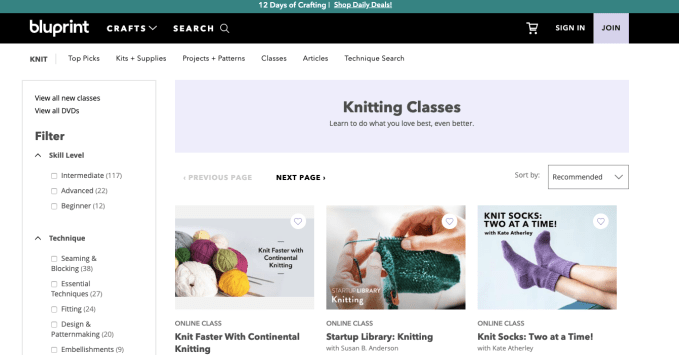Technology
Today the tech-heavy Nasdaq Composite closed at an all-time record high of 8,814.23, up 0.91% on the day.
The Nasdaq is up more than 32% on the year. Turning the clock back, the Nasdaq Composite is up around 60% from the end of 2016. Compared to the anti-records set in 2009 during the doldrums that followed the 2008 crisis, the Nasdaq is up a staggering 594%.
The huge run in value of technology stocks since the last recession is historic. And, given the length of the current global economic expansion, somewhat lost on regular folks.
Times aregood, and itworth reminding ourselves of how good. After all, the private markets — the world of startups, venture capital and the next big companies — follow the public markets& lead. If we understand whatgoing on with tech stocks, we&ll better understand what is happening with your local startup cohort.
Or more precisely, if you&ve been confused about why every startup is worth a bajillion (plus or minus) dollars, this is why.
A record run
Putting todayNasdaq level into historical context is a bit difficult. It has been so long since the last, lasting correction in the value of technology companies that their aggregate share price chart is simply up and to the right. Can you recall the last time tech stocks dropped real value, and stayed down?
Probably not. The reason why is that compared to the post-2008 expansion, the 2000-era technology bubble appears small, pathetic and short-lived. Via YCharts, herea look at the Nasdaq Composite going back into the &80s:

That, in a nutshell is why there are so many unicorns in the market; that chart is why SaaS multiples are still around 10-11x ARR (per Bessemer, which is rebuilding its cloud index page at the moment). That chart is a part of why Ubervaluation got ahead of its real value. Italso why venture capital funds have gotten larger, private equity deals more expensive and SoftBank may raise a second Vision Fund despite a host of high-profile wobbles. Ithow Microsoft added mow than 50% of its totalvalue this year.
You get the idea.
The stock market is incredibly strong right now, a fact that is pushing lots of private investors to pay more for growth in anticipation that companies& revenue multiples will stay high (as dictated by public comps, or what larger companies are willing to pay for startups). So long as the Nasdaq keeps going up, that bet makes the punters look smart.
So what?
We could have written this post a few times in the past week, let alone this year. Of course, we can&t post a similar entry every time a tech-focused index hits a new record high — you&d fine it repetitive. But we also can&t not mention it every time, as it is critical to recall that todaywarm climate for startups is predicated on a public market trend that will not — cannot — last.
When will things change? No one knows. So far this December thereno mini-crash to worry about. Things just look good, and healthy, and flush with new records.
- Details
- Category: Technology
Read more: As the Nasdaq sets new records, a reminder how highly valued tech stocks are today
Write comment (94 Comments)Instagram is giving politicians the same free rein to spread misinformation as its parent company Facebook. Instagram is expanding its limited fact-checking test in the U.S. from May and will now work with 45 third-party organizations to assess the truthfulness of photo and video content on its app. Material rated as false will be hidden from the Explore and hashtag pages, and covered with an interstitial warning blocking the content in the feed or Stories until users tap again to see the post.
This goes an important step further than Facebook early attempts to append warnings on links alongside content but that still let users immediately consume the misinformation. In October Facebook announced it would use a similar interstitial warning system.

Instagram will use image matching technology to find additional copies of false content and apply the same label, and do this across Facebook and Instagram content. That could become a talking point for Facebook as it tries to dissuade regulators from breaking up the company and spinning off Instagram. On the other hand, ita valuable economy of scale for protecting the internet. Breaking up Facebook, Instagram and WhatsApp might lead to worse enforcement through fragmented resources, though it could lead the apps to compete for the best moderation.
Instagram is trying to beef up its safety practices across the board. Today it began alerting users that the caption they&re about to post on a photo or video could be offensive or seen as bullying, offering them a chance to edit the text before they post it. Instagram started doing the same for comments earlier this year. Instagram is also starting to ask new users their age to make sure they&re 13 or older, which I&d previously written it needed to add since it was otherwise feigning ignorance to dodge Child Online Privacy Protection Act violation fines.

One group thatexempt from the fact checking, though, is politicians. Their original content on Instagram, including ads, will not be sent for fact checks, even if itblatantly inaccurate. This aligns with Facebookpolicy thatreceived plenty of backlash from critics, including TechCrunch, who say it could let candidates smear their rivals, stoke polarization and raise money through lies. Instagram CEO Adam Mosseri has maintained that banning political ads could hurt challenger candidates in need of promotion, and that it would be tough to draw the lines between political and issue ads.
Instagram is luckily less dangerous in this respect because feed posts can&t directly link out to websites where politicians could raise money. But verified users can attach links to Stories, and everyone can have one link in the profile. That means false information could still be knowingly weaponized by politicians on the app, furthering their campaigns at the expense of truth… and peopleperception that they can believe what they see on Instagram.
- Details
- Category: Technology
Read more: Instagram hides false content behind warnings, except for politicians
Write comment (97 Comments)
Plenty of the ocean remains unexplored, even though ita huge trove of potentially valuable information. Current methods for mapping and gathering ocean data, especially deep-ocean data, generally require humans in the mix (even if controlling vehicles remotely), are immensely expensive and are not designed for long periods of operation. Startup Terradepth, founded by two ex-Navy SEALs and based in Austin, Texas, is aiming to change all that using autonomous submersible vehicles that can, if deployed as a fleet with adequate scale, provide access to deep-ocean information on a data-as-a-service basis.
The startup has raised $8 million in funding in a new round led by storage hardware company Seagate Technology, and the funding will help it pursue its ambitious goal of demonstrating their technology at work in an open-water environment by next summer. From there, it hopes to scale its operations the following year, and ultimately operate an entire networked fleet of its fully autonomous underwater robots, which it calls &Autonomous Hybrid Vehicles,& or AxV.
Terradepth says that its technology will be able to operate at a scale and cost not previously possible because of their use of autonomous navigation, and it will aim to offer raw data, information processed through their own machine-learning powered analytics layer, or cloud-based third-party analytics. They aim to offer multispectral imaging, surveillance and monitoring/forecasting services for off-shore equipment and resources.
In addition to co-founders Joe Wolfel and Judson Kauffman, Terradepthsmall team includes a range of roboticists and engineers with expertise in both software and hardware. Their vehicles are designed to alternate between deep ocean passes and trips to the watersurface, with underwater AxV communicating with the surface-based robots, which are simultaneously recharging, which then pass on data collected to satellites for relaying back to data centers and customers.
- Details
- Category: Technology
Read more: Terradepth raises $8 million to build a fleet of autonomous deep-ocean data robots
Write comment (90 Comments)
The world of healthcare has notoriously been described as &broken& — plagued with high-friction workflows, sky-high costs and convoluted business models.
Over the past several years, a long list of innovative startups and salivating venture investors have pinned their focus on repairing the healthcare industry, but its digital transformation still appears to be in the very early innings. After a record-setting 2018, however, digital health investing continued to reach meteoric heights in 2019.
Mammoth pools of capital have flooded into various sub-verticals and business models, backing collections of new B2B and B2C companies focused on optimizing healthcare workflows, improving healthcare access and offering lower-cost distribution models. Over the past two years, digital health startups have raised well over $10 billion in funding across nearly 1,000 deals, according to data from Pitchbook and Crunchbase.
As we close out another strong year for innovation and venture investing in the sector, we asked nine leading VCs who work at firms spanning early to growth stages to share whatexciting them most and where they see opportunity in the sector:
- Annie Case, Kleiner Perkins
- Zavain Dar, Lux Capital
- Adam Goulburn, Lux Capital
- Kristin Baker Spohn, CRV
- Raju Rishi, RRE Ventures
- Olivia Lew, General Catalyst
- Bill Liao, SOSV
- Jennifer Hartt, Ben Franklin Technology Partners
- John Prendergass, Ben Franklin Technology Partners
Participants discuss trends in digital therapeutics, telehealth, mental health and the latest in biotech and medical devices, while also diving into startups improving medical practitioner efficiency, evaluating the evolving regulatory environment and debating valuations and offering a ‘temp check& on the market for digital health startups leveraging ML.
Annie Case, Kleiner Perkins
Although Kleiner Perkins has a long history of investing in iconic health companies, we believe it is still the early innings of digital health as a category today.
When I evaluate new opportunities in the space, I often start by thinking through how the company will move the needle on cost, quality, and access to care — the &iron triangle& of health care systems. Conventional wisdom has been that itimpossible to improve all three dimensions simultaneously, but we are seeing companies leverage technology to shift this paradigm in meaningful ways.
Itno longer just a promise. For example, Viz.ai is using artificial intelligence to detect and alert stroke teams to suspected large vessel occlusion strokes, enabling patients to get treatment faster. Their workflows improve access to life-saving care, deliver higher quality through reduced time to treatment (every minute counts as ‘time is brain& in stroke care), and dramatically reduce the costs associated with long-term disability.
We are also seeing companies provide this type of tech-enabled care outside of the hospital setting. Modern Health is a mental health benefits platform that employers are making available to their employees. The platform triages individual employees to the right level of care, providing clinical care to those with diagnosable depression or anxiety, and making self-guided or preventative care available to everyone else. Their solution improves quality and access by offering mental health services to every employee and reduces the cost associated with untreated mental illness, lost productivity, or employee churn.
Heading into 2020, we&re eager to back digital health companies in new areas that leverage technology to impact cost, quality, and access. A few spaces that I&m excited about are behavioral health (mental health, substance abuse, addiction, etc), care navigation, digital therapeutics, and new models integrating telehealth, remote care and AI to better leverage medical professionals& time.
Zavain Dar and Adam Goulburn, Lux Capital
Below are some thoughts and coming predictions on health tech broadly:
- Digital therapeutics continue to pick up steam — on the back of Pear and Akili, more companies push to FDA and enter the market. In addition, broader consumer platforms like Calm and Headspace look to broaden their offerings by investigating clinical approvals.
- At least one major pharma looks to expand its consumer surface area by acquiring one of the new digital, consumer-facing generics platform (ex Hims, Ro, NuRx).
- Venture funding for biotech continues to boom with at least three Series Aof $100M or more in size.
- Drug discovery for neurodegeneration sees a renaissance. High-profile failings of Biogen and the beta-amyloid hypothesis sees a shift of innovation to early-stage biotech and venture creation.
- Big pharma has its DeepMind moment acquiring at least one machine-learning (AI) enabled drug discovery company.
- Clinical trial tech investments heat up; new companies and technologies emerge to make trials patients first and systems get smarter at finding the right patients at their point of care; large incumbents like IQVIA, LabCorp and PPD get acquisitive.
- At least three traditional Sand Hill Road tech venture firms open life science practices or raise dedicated funds.
- Machine learning targets chemistry driven by large advancements in transformer (NLP) models; has the time for computational chemistry finally come?
- HCIT sees a renaissance driven by increased CIO responsibility towards data interoperability. Companies either working on federated ML to allow systems to speak to each other or lightweight edge applications enabling rapid clinical deployment will see quick uptake and traction, until now impossible in HC.
Kristin Baker Spohn, CRV
In the last 10 years, digital health has exploded. Over $16B has been invested in the sector by VCs and we&ve seen IPOs from Livongo, Progyny and Health Catalyst, just in the last year alone. That said, therestill a lot that mystifies people about the sector — there are spots that are overheated and models that will struggle to deliver venture scale outcomes. I&ve seen digital health evolve first hand as both an operator and investor, and I&m more excited than ever about the future of the space.
A few areas and trends that I&ve been following recently include:
- Details
- Category: Technology
Read more: Where top VCs are investing in digital health
Write comment (90 Comments)Welcome to TechCrunch2019 Holiday Gift Guide! Need help with gift ideas? We&re here to help! We&ll be rolling out gift guides from now through the end of December. You can find our other guides right here.
The history of textiles and computing are closely intertwined, with the punch cards used for Jacquard looms inspiring the design of Charles BabbageAnalytical Engine, one of the earliest computers. Two centuries later, the structure of knitted fabrics is being studied by researchers for their potential applications in soft robotics and other technologies.
Aside from their close association with tech, the mental benefits of crafting, whether it involves fiber, textiles or other materials, have been well-documented. Here are some ideas for the textile artists you know (or aspiring ones).
This article contains links to affiliate partners where available. When you buy through these links, TechCrunch may earn an affiliate commission.
Make: Tech DIY: Easy Electronics Projects for Parents and Kids

Created by educators Ji Sun Lee and Jaymes Dec, this book teaches electronic basics by combining circuitry, conductive sewing and fabric in projects that include plush animals, wearables and a board game. All materials are easy to find at craft and hardware stores.
Price: $10.99 (Kindle), $13.48 (paperback) on Amazon
Get started with plant dyes
Start using plants to dye fiber, yarn and textiles with kits from The Love of Colours, which have pre-measured ingredients.

Price: Starting from $22.95 on Etsy
Learn how to make plant dyes
Learn more about plant dyes in &The Modern Natural Dyer& by Kristine Vejar, the owner of Oakland, Calif. yarn and fabric store A Verb for Keeping Warm. Their online shop also carries a selection of kits.

Price: $29.95 at A Verb for Keeping Warm
Learn tapestry weaving
Designed for kids, Melissa and Dougsimple wooden tapestry loom is also a great way for adults to start weaving.

Price: $23.99 at Amazon
Rigid heddle loom
The Ashford SampleIt Loom is small and portable, but lets your gift recipient sample a variety of rigid heddle weaving techniques to create different textures and patterns. At 16& wide, it is ideal for weaving scarves, but lengths of finished weaving can also be sewn together into other items.

Price: $180 at the Woolery
Drop spindle starter kit
Spinning fiber into yarn on a drop spindle is one of the earliest fiber techniques. The Kromski Drop Spindle kit contains everything your recipient needs to get started, including a drop spindle, merino wool and instructions.

Price: $32 at the Woolery
3D-printed drop spindle
For experienced spinners who want more control, the Trillium Drop Spindle, made from 3D-printed nylon, comes with interchangeable silicone beads that change the weight of the spindle, making it easier to control the thickness of yarn.

Price: $49 at the Woolery
Electric Eel Wheel Nano
For spinners who want to move beyond drop spindles, but don&t have the space or budget for a traditional spinning wheel, the Electric Eel Wheel Nano is an affordable alternative that can be plugged into a wall socket or used with a battery pack to make it more portable.

Price: $80 to $110 at Dreaming Robots
Fiber packs
Now that your gift recipient has a loom, drop spindle or spinning wheel, they will need fiber. Fūnem Studiofiber packs are sorted into coordinating colors and come with yarn or wool roving, which can be spun or woven into projects.

Price: Starting from about $28 on Etsy
Learn how to knit
Known for their quality, sustainably sourced yarn, Wool and the Gangbeginner kits come with everything a brand-new knitter needs to get started. They can make projects ranging from hats and scarves to sweaters.

Price: Starting from about $31 at Wool and the Gang
Addi Express King Size Knitting Machine
Want to knit more quickly? Addisturdy machine lets users knit long tubes or flat panels at speed that can be stitched together into clothing and blankets.

Price: $229.99 on Amazon
The history of computing and looms
Want to learn more about how Jacquard looms inspired computing design? &JacquardWeb: How a Hand-Loom Led to the Birth of the Information Age& by James Essinger delves into the subject in detail.

Price: $9.99 (Kindle), $11.78 (hardcover), $19.96 (paperback)
Bluprint
A subscription to Bluprint means access to a ton of resources, including well-made video classes, patterns and instructions, for a wide range of DIY projects.

Price: $7.99 (monthly) or $79.99 (annual)
- Details
- Category: Technology
Read more: Gift Guide: Gifts that weave together tech, science and textile crafts
Write comment (91 Comments)
Itnot enough for an autonomous vehicle to see the world around it. These vehicles need to understand in real time what they&re seeing.
That understanding piece is critical, and it requires being able to identify objects in real time and in any environmental condition. It can mean the difference between an autonomous vehicle that appropriately notices and ignores a plastic bag floating by and one that slams on its brakes.
Tel Aviv-based startup Arbe has developed a high-resolution radar chipset that it says is a game changer for the automotive industry. Now, with a fresh injection of $32 million in capital, itpushing to bring it into production and into the hands of Tier 1 suppliers.
Arbe said Monday that it has raised $32 million in a Series B funding round from a number of new investors, including BAIC Capital, Catalyst CEL, MissionBlue Capital and AI Alliance, a joint venture fund that includes Hyundai, SK Telecom and Hanwha Asset Management. Existing investorsCanaan Partners Israel, iAngels, 360 Capital Partners, O.G. Tech Ventures and OurCrowd also participated.
Arbe will use the capital to hire more employees. But its big focus in the coming year is to bring its radar systems into full production.
&With the funds raised, Arbe will continue to deploy to the market a real breakthrough in radar technology that empowers Tier 1 automakers and OEMs to finally replace their legacy chipsets with one that truly meets the safety requirements of NCAP and ADAS for years ahead,& CEO Kobi Marenko said in a statement.
Arbe already has five Tier 1 customers — two in China and three in Europe, Marenko told TechCrunch. Marenko wouldn&t name the suppliers.
Arbe developed a high-resolution radar chipset designed to help autonomous vehicles, and even passenger vehicles equipped with advanced driver assistance systems, detect and identify objects.The technology can separate, identify and track hundreds of objects in high horizontal and vertical resolution to a long range in a wide field of view. Arbe says its radar chipset generates an image 100 times more detailed than any other solution on the market today. The system is then able to take those images and simultaneously localize and map the environment.
The high-resolution radar chipset resolves a number of issues found in legacy chipsets, Marenko said, including eliminating false alarms. Arbechipsets also can in real time process massive amounts of information generated by 4D imaging, and mitigate mutual radar interference. A radar system that has high-resolution object separation in azimuth and elevation will theoretically lead to more accurate decision making.
Arbe is so confident in its radar chipset that Marenko says it will enable Level 3 automation in passenger vehicles without requiring lidar, or light detection and ranging radar. Level 3 is a designation by SAE that means conditional automation in which a driver must still be prepared to intervene.
- Details
- Category: Technology
Read more: Arbe raises $32 million to bring its high-resolution radar to autonomous vehicles
Write comment (93 Comments)Page 114 of 5614

 17
17